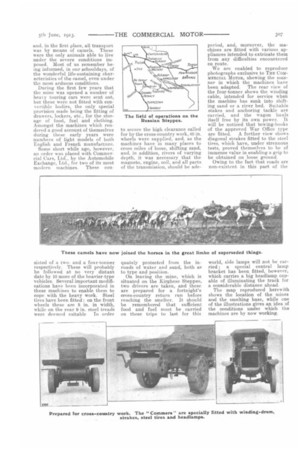Commers Oust Camels.
Page 8

Page 9

If you've noticed an error in this article please click here to report it so we can fix it.
English-built Machines Undertake Cross-country Journeys of Two Weeks Duration Over the Russian Steppes, Carrying all Food, Fuel and Supplies.
A feature of the stage to which the commercial-vehicle industry has now attained, and perhaps one of its most-interesting characteristics, is the manner in which exceptional methods of transport are being superseded by one or other of the tried and approved makes of commercial vehicles.
It came as something of a shock to many of our readers to learn that the commercial vehicle had advanced so far in regard to practical application that it had commenced to oust the plough horse. The cultivation of the land had been carried out by steam haulage for many years past, but the advent of the small motor-driven single-share plough marked a new era in the development of the industry. It is now possible to challenge the relative economy of the horse-drawn plough with success. We have now to write of an exampleof substitution Overseas which is quite as remarkable and perhaps even more picturesque. English-built commercial-motor vehicles are now being used and are likely to be employed on a still greater scale in the near future, for work which has hitherto only been possible with camels.
It is a far cry to the Russian Steppes. And it is a tribute to the confidence inspired by British-built heavy motors that a Russian mining company is superseding its camel transport with English-built motors.
We recently had a chat with Mr. W. S. Oakley, of the Automobile Exchange, Ltd., Great Portland Street, W. This company has received instructions from the Spassky Copper Mine, Ltd., to supply motors for the transport of material and supplies from the railhead at Djoosale on the Tishkerdt Railway to the new smelter to be erected at the Atbasar Co.'s property—a property recently belonging to the Atbasar Copper Fields, Ltd., and now in process of being absorbed by the Spassky Co. There, are no regular roads, the material having to be transported 250 miles over the bare and uncultivated Steppes.
The mine was started in 1904, and, in the first place, all transport was by means of camels. These were the only animals able to live under the severe conditions imposed. Most of us remember being informed, in our 'schooldays, of the wonderful life-sustaining characteristics of the camel even under the most arduous conditions.
During the first few years that the mine was opened a number of heavy touring cars were sent out, but these were not fitted with convertible bodies, the only special provision made being the fitting of drawers, lockers, etc., for the storage of food, fuel and clothing. Amongst the machines which rendered a good account of themselves during these early years were numbers of light models of both English and French manufacture.
Some short while ago, however, an order was placed with Commercial Cars, Ltd., by the Automobile Exchange, Ltd., for two of its most modern machines. These con sisted of a twoand a four-thriller respectively. These will probably be followed at no very distant date by 10 more of the heavier-type vehicles. Several important modifications have been incorporated in these machines to enable them to cope with the heavy work. Steel tires have been fitted : on the front wheels these are 5 in. in width, while on the rear 9 in. steel treads were deemed suitable In order
to secure the high clearance called for by the cross-country work, 40 in. wheels were supplied, and, as the machines have in many places to cross miles of loose, shifting sand, and, in addition, rivers of varying depth, it was necessary that the magneto, engine, coil, and all parts of the transmission, should be ade
quately protected from the inroads of water and sand, both as to type and position. On leaving the mine, which is situated on the Kirghese Steppes, two drivers are taken, and these are prepared for a fortnight's cross-country return run before reaching the smelter. It should be remembered that sufficient food and fuel must be carried on these trips to last for this period, and, moreover, the machines are fitted with various appliances intended to extricate them from any difficulties encountered en route.
We are enabled to reproduce photographs exclusive to THE ComMERCIAL MOTOR, showing the manner in which the machines have been adapted. The rear view of the four-tonner shows the winding cable, intended for service when the machine has sunk into shifting sand or a river bed. Suitable stakes and anchoring tackle are carried, and the wagon hauls itself free by its own power. It will be noticed that towing-hooks of the approved War Office type are fitted. A further view shows diagonal strakes fitted to the steel tires, which have, under strenuous tests, proved themselves to be of immense value in enabling a grip to be obtained on loose ground. Owing to the fact that roads are non-existent in this part of the world, side lamps will not be carried; a special central lamp bracket has been fitted, however, which carries a big headlamp capable of illuminating the track for a considerable distance ahead.
The map reproduced herewith shows the location of the mines and the smelting base, while one of the illustrations gives an idea of the conditions under which the machines are by now working.


























